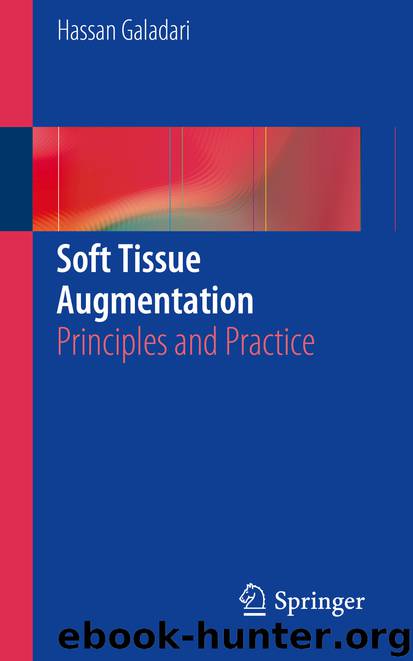Soft Tissue Augmentation by Hassan Galadari

Author:Hassan Galadari
Language: eng
Format: epub
ISBN: 9783662558447
Publisher: Springer Berlin Heidelberg
Anatomically the layers of the middle third are comprised of the skin, fat compartments , both superficial and deep, muscles and bones of the skeleton. With aging many changes occur in those areas. Both superficial and deep fat compartments tend to undergo volumetric changes with a decrease in the size of those compartments. That being said, not all compartments undergo the same volume loss with time. The nasolabial fold (NLF) fat compartment , for example, does not decrease with time when compared to its neighboring compartments and may show a relative increase. This is important to realize as this negates the old age adage of injecting the NLFs. As a matter of fact, this proves that injecting the NLFs will cause a much more unnatural result.
Blood circulation in the area is restricted to the middle part of the middle third and compromises of branches of the facial artery , mainly the angular which tends to branch off to feed the nose and the transverse facial artery . In addition the infraorbital artery also comes off of the infraorbital foramen . Though difficult to palpate, the foramen is found slightly medial the supraorbital foramen and opens at a downward angle from the maxilla about 1 cm from inferior orbital rim . This is important as injection in that area can be perpendicular at a 90° when placing a bolus, but an angled injection introduced from the lower part of the cheek upwards should be avoided as to not lacerate the artery. Thus, when it comes to filler injection and this artery being the most prominent in the mid cheek , it is important to inject from the lateral end to the medial with the injection point being on the zygoma and moving medially to the maxilla. This will insure that any potential damage to the vessel is avoided.
The angular artery passes by the pyriform fossa, a depression lateral to the nose . While this vessel is deep at first, it starts moving further superficial and in that area it is relatively found lying just in the subdermal plane. This is important to know because though the NLFs may be injected with fillers in the dermal/subdermal plane, once the superior part that is lateral to the nose is augmented, injection should be placed deeply onto bone to avoid any potential complication, as neurovascular compromise into the area will lead to potential necrosis across the side of the nose and above it. This may be avoided with the use of cannulas.
The vessels feeding the nose are branches of the angular artery and anastomose with those arising from the infraorbital and supratrochlear arteries. This makes this location the most sensitive in terms of potentially causing adverse events. The nasal arteries lie on the lateral walls and anastomose on the bridge of the nose and dorsum. This clinically is translated into injections needing to be made strictly on the midline and in the deeper plane. It is important to know that even when injecting with
Download
This site does not store any files on its server. We only index and link to content provided by other sites. Please contact the content providers to delete copyright contents if any and email us, we'll remove relevant links or contents immediately.
| Anesthesiology | Colon & Rectal |
| General Surgery | Laparoscopic & Robotic |
| Neurosurgery | Ophthalmology |
| Oral & Maxillofacial | Orthopedics |
| Otolaryngology | Plastic |
| Thoracic & Vascular | Transplants |
| Trauma |
Periodization Training for Sports by Tudor Bompa(8170)
Why We Sleep: Unlocking the Power of Sleep and Dreams by Matthew Walker(6618)
Paper Towns by Green John(5091)
The Immortal Life of Henrietta Lacks by Rebecca Skloot(4525)
The Sports Rules Book by Human Kinetics(4294)
Dynamic Alignment Through Imagery by Eric Franklin(4118)
ACSM's Complete Guide to Fitness & Health by ACSM(3989)
Kaplan MCAT Organic Chemistry Review: Created for MCAT 2015 (Kaplan Test Prep) by Kaplan(3940)
Introduction to Kinesiology by Shirl J. Hoffman(3726)
Livewired by David Eagleman(3684)
The Death of the Heart by Elizabeth Bowen(3552)
The River of Consciousness by Oliver Sacks(3541)
Alchemy and Alchemists by C. J. S. Thompson(3451)
Bad Pharma by Ben Goldacre(3357)
Descartes' Error by Antonio Damasio(3230)
The Emperor of All Maladies: A Biography of Cancer by Siddhartha Mukherjee(3066)
The Gene: An Intimate History by Siddhartha Mukherjee(3047)
The Fate of Rome: Climate, Disease, and the End of an Empire (The Princeton History of the Ancient World) by Kyle Harper(3003)
Kaplan MCAT Behavioral Sciences Review: Created for MCAT 2015 (Kaplan Test Prep) by Kaplan(2940)
